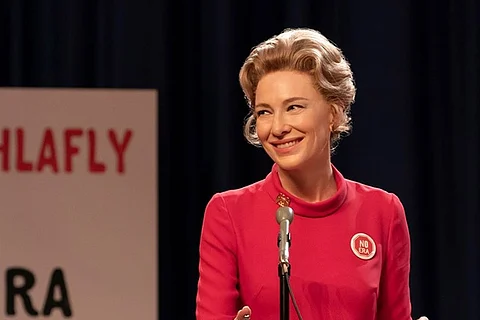

About halfway through the nine-episode miniseries Mrs. America, there’s a callout to the late Nora Ephron. The journalist-turned-film director had written about the women’s liberation movement for Esquire in the 1970s, and naturally, I began searching for her famous essay, which follows the Democratic Convention and the storied figures connected to the National Women’s Political Caucus. There’s activist Gloria Steinam and former Congresswoman Bella Abzug, having their pictures taken at every turn, and Betty Friedan, who authored the seminal book The Feminine Mystique, her eyes “darting back and forth trying to catch someone’s attention, anyone’s attention. No use.”
As Friedan says in the show, “Nora doesn’t need convincing to write something bitchy.” But it’s also a testament to show creator Dahvi Waller (who also wrote for Mad Men) that Mrs. America’s carefully-wrought details and character portrayals so closely parallel Ephron’s essay. After each episode, it’s almost impossible not to search the internet for the historical counterparts and real-life moments depicted on screen.
The show, which is streaming on Hotstar, follows two factions of women, and each episode highlights a particular person or moment in history. One faction is fighting for the approval of the Equal Rights Amendment (ERA), which would provide constitutional equality to women and men. The other is fighting against it. The latter gives Mrs. America its most central character in the form of Phyllis Schlafly, played by Cate Blanchett, an anti-feminist figure who leads the ‘Stop ERA’ camp and sees the liberation movement as a threat to the lives and privileges of suburban homemakers. Schlafly rejects notions of working women and pushes for conservative family values (and denigrates those who don’t follow). She appeals to lawmakers to reject the ERA by bringing them loaves of bread and jam, with notes that read, “From the breadmakers, to the breadwinners.” She frequently thanks her husband for allowing her to attend public events (which she admittedly does only to rile up “the libbers”).
At the same time, she forges ahead with her own political ambitions, enrols in law school and brushes aside women whose family lives have turned untenable and even abusive. Even as her own cohort of white upper-class homemakers help push Schlafly’s message forward, there are times they too are left wondering what they are really fighting for. One exchange between Bella Abzug (Margo Martindale) and Alice (Sarah Paulson), a close friend of Schlafly’s, goes like this:
Bella: Has she taught you how to lobby a legislator?
Alice: Of course
Bella: Has she taught you how to draft a press release? A speech?
Alice: Yes
Bella: How to answer reporters' questions? Get the television interview?
Alice: Yes
Bella: How to create a budget and balance it?
Alice: Yes
Bella: Congratulations. You're working girls.
In the show, the liberation movement is seemingly the one with power, while Schlafly’s work still relies on grassroots advocacy. The 1970s were the height of women’s political power in the United States, the show says in its final episode. These women had the ear of the President and the First Lady. They vocalised major political platforms that caught national media attention. Yet Mrs. America is most interesting when it depicts the struggles within the women’s liberation movement. Their efforts toward the passage of the ERA were ultimately unsuccessful after a handful of states failed to ratify the amendment before the deadline. Decades later, in January 2020, Virginia finally ratified the ERA, an important step in the ongoing movement for women’s rights, but a largely symbolic one. As Rose Byrne, who plays Steinam, says in an interview, “You understand why feminists are furious,” she says. “We’re still talking about this?”
On both sides, there is racism and discrimination, a fact that’s even harder to ignore as America has erupted in protests over racist police violence inextricably linked to the country’s past and present. Schlafly turns a blind eye to racist rhetoric and groups in order to further her movement, and is frequently dismissive of unmarried women without families. The feminism practiced by the leaders portrayed in Mrs America is often focused on white, radically-liberal and urban women, and the issues they deem most critical. That often comes at the expense of other messages — those of lesbians, transgender persons, black women and women of colour — whose struggles are sometimes seen as secondary and perhaps even weakening the overall movement. Only one episode focuses directly on a woman of colour — Shirley Chisholm, played by Uzo Aduba, who was the first woman and African American to seek the presidential nomination from one of the two major political parties. When she criticises Bella and Gloria for failing to stand with her campaign, it’s a critique on a kind of solidarity that’s politically convenient.
Ultimately, there is a right and wrong side to history, and the show makes no secret of where it ends up. It also shows a movement is only as strong as those who stand with it. In the final episode, Abzug is fired from her position as head of the Women’s Rights Commission, even as she’s made to believe her work is valuable. The women around her tender their own resignations in support. On the other side, the real-life Schlafly would go on to shape American politics through her brand of conservatism. In the show, we leave her sitting alone at her kitchen table, peeling apples to bake a pie, her political dreams crashing down around her.